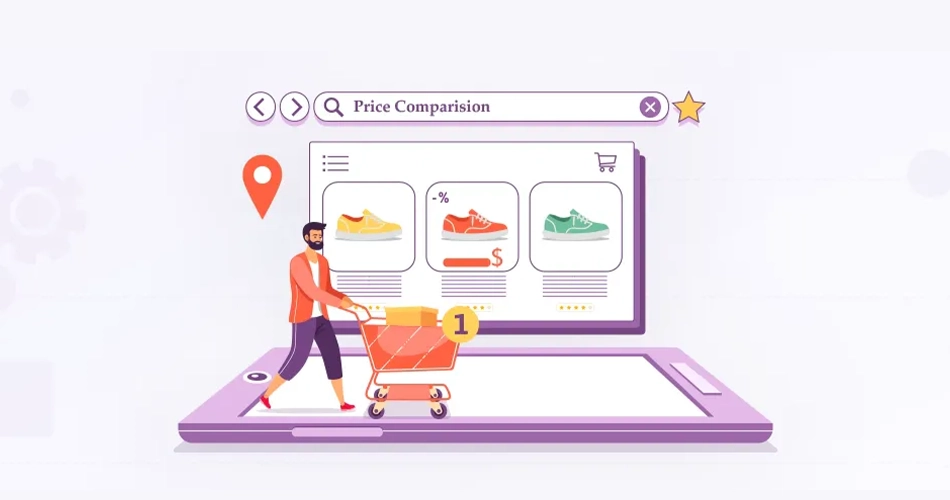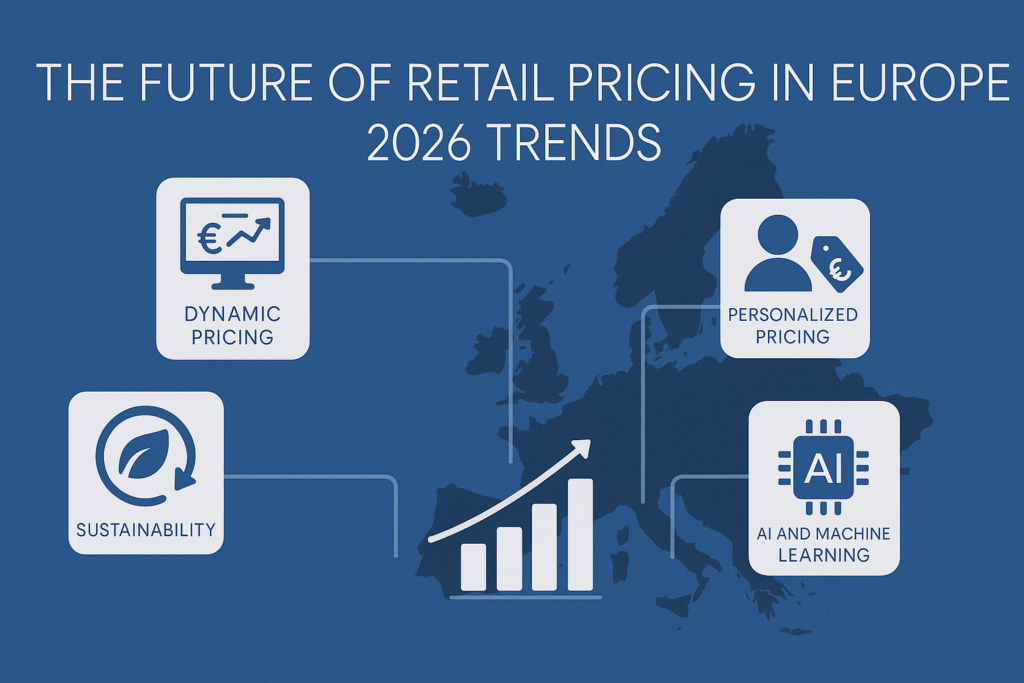- Product
- Solution for
For Your Industry
- Plans & Pricing
- Company
- Resources
For Your Industry
In the highly competitive world of online retail, price comparison has become an essential tool for success. With countless competitors just a click away, consumers are always on the lookout for the best deal. For retailers, this means that pricing strategies need to be precise, agile, and data-driven.
Price comparison not only helps businesses stay competitive but also enhances customer experience, improves profitability, and ensures retailers maintain a strong foothold in the market. In this comprehensive guide, we will dive deep into the basics of price comparison, its key benefits, use cases, best practices, and how online retailers can optimize their strategies for long-term success.

Price comparison, as the term suggests, involves systematically monitoring the prices of competitors in your market. This practice allows businesses to gather valuable data on how their prices stack up against those of other retailers offering similar products.
In an age where customers can compare prices with a few clicks, leveraging real-time price comparison data has become a critical component of any retailer’s strategy. Whether you’re running a large e-commerce platform or a smaller online store, price comparison enables you to make informed decisions about your pricing and stay competitive in a rapidly changing market.
Price comparison offers insights into market trends and consumer behavior. By monitoring competitors’ prices, you can determine the standard market pricing for specific products. This not only helps with benchmarking but also in identifying seasonal fluctuations and shifts in demand.
Today’s consumers are armed with tools that allow them to make fast, educated decisions about where to buy. If your prices aren’t competitive or properly optimized, customers will simply move on to your competitors. By engaging in effective price comparison, retailers can maintain transparency and position themselves as a trustworthy choice.
Many customers base their purchasing decisions on price, especially when they’re deciding between similar products. Offering competitive prices—while ensuring profitability—can give your business the edge in attracting these budget-conscious shoppers.
Price comparison allows you to benchmark your prices against competitors. This helps you gauge how well you are positioned in the market. You can identify pricing trends, promotions, and changes that your competitors may be making and adjust your own pricing accordingly. This continuous adjustment ensures that you don’t overprice (risking losing customers) or underprice (cutting into your margins unnecessarily).
Pricing strategies become more accurate and dynamic with price comparison. By analyzing the price fluctuations of competitors, you can adjust your own pricing in real time, boosting conversions and profitability. For instance, if you notice a competitor has lowered the price of a product, you can quickly react and adjust your own to maintain competitiveness.
Accurate price comparison helps in identifying opportunities for raising or lowering prices without losing customers. For example, if competitors are pricing too low for profitability, and your analysis shows that consumers are willing to pay slightly more for added value (such as superior customer service or fast shipping), you can increase your price without affecting sales, thus improving your profit margins.
Customers expect transparency and fair pricing. By offering competitive pricing, you not only meet customer expectations but also build loyalty and trust. Price comparison tools ensure that your customers see you as providing good value for money, improving the overall shopping experience and increasing customer retention.
With the right price comparison tools, retailers gain real-time insights into market pricing trends. This allows for quick adjustments and gives you the flexibility to remain competitive in a volatile market. Staying agile and responding swiftly to price changes can give you a significant competitive advantage.
Price comparison isn’t just about ensuring your prices match competitors—it’s a versatile tool with many applications in e-commerce, helping retailers optimize every aspect of their business.
Setting the correct price for a new product can be challenging. Launching a product with too high a price risks low adoption, while too low a price can devalue your offering. By conducting a thorough price comparison before the launch, you can determine the ideal price point based on current market conditions and competitor prices.
Running a promotion without understanding competitor pricing could be a costly mistake. Retailers need to ensure that their promotional offers are competitive while also profitable. For example, during peak seasons like Black Friday or Cyber Monday, price comparison helps retailers offer timely discounts without sacrificing margins.
Effective inventory management depends largely on price optimization. Slow-moving products can be identified, and prices adjusted to stimulate sales. Conversely, in-demand products may allow for price increases. Price comparison allows you to track the performance of similar products across the market, helping you to determine the most profitable pricing strategy.
If you’re looking to expand into international markets, understanding how your product is priced in those regions is essential. Price comparison allows retailers to tailor their pricing strategies based on regional demand, currency fluctuations, and the local competitive landscape.
Retailers like Amazon are famous for dynamic pricing strategies—adjusting prices in real time based on competitor activity, demand, and customer behavior. For smaller retailers, price comparison enables dynamic pricing, allowing you to stay competitive without manually updating prices. Price comparison also supports price-matching policies, which can help capture more sales.
Manually comparing prices across hundreds or thousands of products is time-consuming and inefficient. This is where price comparison software comes in. The best tools offer automated price tracking, allowing you to focus on making strategic adjustments rather than gathering data.
To make data-driven decisions, you need to track the right metrics. Here are a few essential metrics for price comparison:
By understanding these metrics, you can make better pricing decisions and remain agile in your approach.
Don’t just match prices—understand why your competitors set their prices the way they do. Are they running a promotion? Are they clearing out inventory? Identifying patterns in competitor behavior will help you predict future moves, allowing you to stay one step ahead.
While being competitive on price is important, it’s also crucial to remember that some customers prioritize value over low prices. Offering premium services like free shipping, superior customer support, or fast delivery can justify slightly higher prices. Striking the right balance between price and value will help attract both price-sensitive and value-focused customers.
The e-commerce landscape is constantly changing. A price that was competitive last week might be too high or too low today. Regularly review your price comparison data and adjust accordingly. Automation tools that provide real-time pricing updates can ensure you never miss an opportunity to stay competitive.
Using automated tools for price comparison is essential for any online retailer. These tools allow you to keep track of thousands of product prices across multiple competitors without needing to manually check each one. Here’s what to look for in a price comparison tool:
Your tool should be able to provide real-time price monitoring across your competitors. This allows you to react quickly to any changes in the market, whether it’s a sudden price drop or a promotion.
Price comparison tools that track historical price data offer insights into trends and patterns. This data is invaluable for understanding how pricing changes impact sales and helps in making long-term strategic decisions.
Automated alerts notify you when a competitor has made a significant change to their pricing. This allows you to adjust your pricing strategy in real time, avoiding losses or missed sales opportunities.
Some price comparison tools come with dynamic pricing integration. This feature automatically adjusts your prices based on pre-set rules, such as matching the lowest competitor price or staying within a specific percentage range.
Accurate SKU (Stock Keeping Unit) matching ensures that you’re comparing identical products across different retailers. Inaccurate comparisons can lead to misinformed pricing decisions, so a tool that can handle SKU matching is a must.
Price comparison is more than just a strategy—it’s a critical component of your business’s success in today’s competitive e-commerce environment. To stay ahead, online retailers must continuously monitor competitor prices, adjust pricing strategies in real-time, and make data-driven decisions to boost profitability. By mastering price comparison, you can improve customer satisfaction, optimize product pricing, and outpace your competition.
To make this process easier, tgndata offers the best-in-class price comparison tool for online retailers. TGNDATA provides real-time price monitoring, competitor analysis, automated alerts, and dynamic pricing integration—all designed to help your business stay competitive and maximize profits.
Don’t leave your pricing strategy to chance—supercharge your business with tgndata. Gain real-time insights, stay ahead of market trends, and ensure your pricing is always competitive.
Take your pricing strategy to the next level—try tgndata today and watch your online retail business thrive!













Missing an important marketplace?
Send us your request to add it!